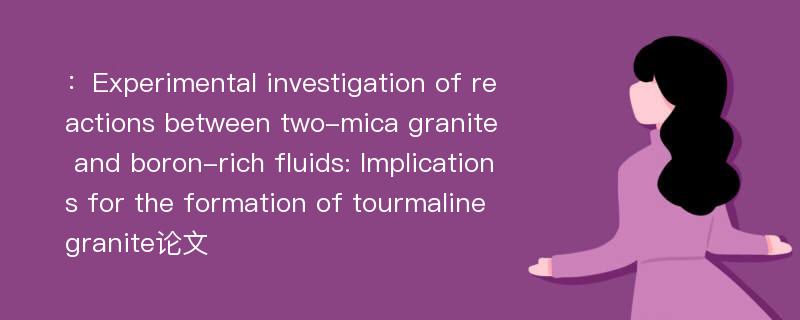
本文主要研究内容
作者(2019)在《Experimental investigation of reactions between two-mica granite and boron-rich fluids: Implications for the formation of tourmaline granite》一文中研究指出:The genetic relationship between different types of granite is critical for understanding the formation and evolution of granitic magma. Fluid-rock interaction experiments between two-mica leucogranite and boron-rich fluids were carried out at 600–700°C and 200 MPa to investigate the effects of boron content in fluid and temperature on the reaction products. Our experimental results show that tourmaline granite can be produced by reactions between boron-rich fluid and two-mica granite.At 700°C, the addition of boron-rich fluid resulted in partial melting of two-mica granite and crystallization of tourmaline from the boron-rich partial melt. Increasing boron concentration in fluid promotes the melting of two-mica granite and the growth of tourmaline. No melt was produced in experiments at 600°C, in which Fe, Mg and Al released from biotite decomposition combined with boron from the fluid to form tourmaline under subsolidus conditions. The Na required for tourmaline crystallization derived from Na/K exchange between feldspar and the K released by biotite decomposition. The produced tourmaline generally has core-rim structures, indicating that the composition of melt or fluid evolved during tourmaline crystallization.Based on the experimental results, we propose that tourmaline granite veins or dikes can be formed by the reactions between boron-rich fluids, presumably produced by devolatilization of boron-bearing granitic magma, and incompletely crystallized granite at the top of the magma chamber. This "self-metasomatism" involving boron-rich fluid in the late stage of magma crystallization could be an important mechanism for the formation of tourmaline granite.
Abstract
The genetic relationship between different types of granite is critical for understanding the formation and evolution of granitic magma. Fluid-rock interaction experiments between two-mica leucogranite and boron-rich fluids were carried out at 600–700°C and 200 MPa to investigate the effects of boron content in fluid and temperature on the reaction products. Our experimental results show that tourmaline granite can be produced by reactions between boron-rich fluid and two-mica granite.At 700°C, the addition of boron-rich fluid resulted in partial melting of two-mica granite and crystallization of tourmaline from the boron-rich partial melt. Increasing boron concentration in fluid promotes the melting of two-mica granite and the growth of tourmaline. No melt was produced in experiments at 600°C, in which Fe, Mg and Al released from biotite decomposition combined with boron from the fluid to form tourmaline under subsolidus conditions. The Na required for tourmaline crystallization derived from Na/K exchange between feldspar and the K released by biotite decomposition. The produced tourmaline generally has core-rim structures, indicating that the composition of melt or fluid evolved during tourmaline crystallization.Based on the experimental results, we propose that tourmaline granite veins or dikes can be formed by the reactions between boron-rich fluids, presumably produced by devolatilization of boron-bearing granitic magma, and incompletely crystallized granite at the top of the magma chamber. This "self-metasomatism" involving boron-rich fluid in the late stage of magma crystallization could be an important mechanism for the formation of tourmaline granite.
论文参考文献
论文详细介绍
论文作者分别是来自Science China(Earth Sciences)的,发表于刊物Science China(Earth Sciences)2019年10期论文,是一篇关于,Science China(Earth Sciences)2019年10期论文的文章。本文可供学术参考使用,各位学者可以免费参考阅读下载,文章观点不代表本站观点,资料来自Science China(Earth Sciences)2019年10期论文网站,若本站收录的文献无意侵犯了您的著作版权,请联系我们删除。
